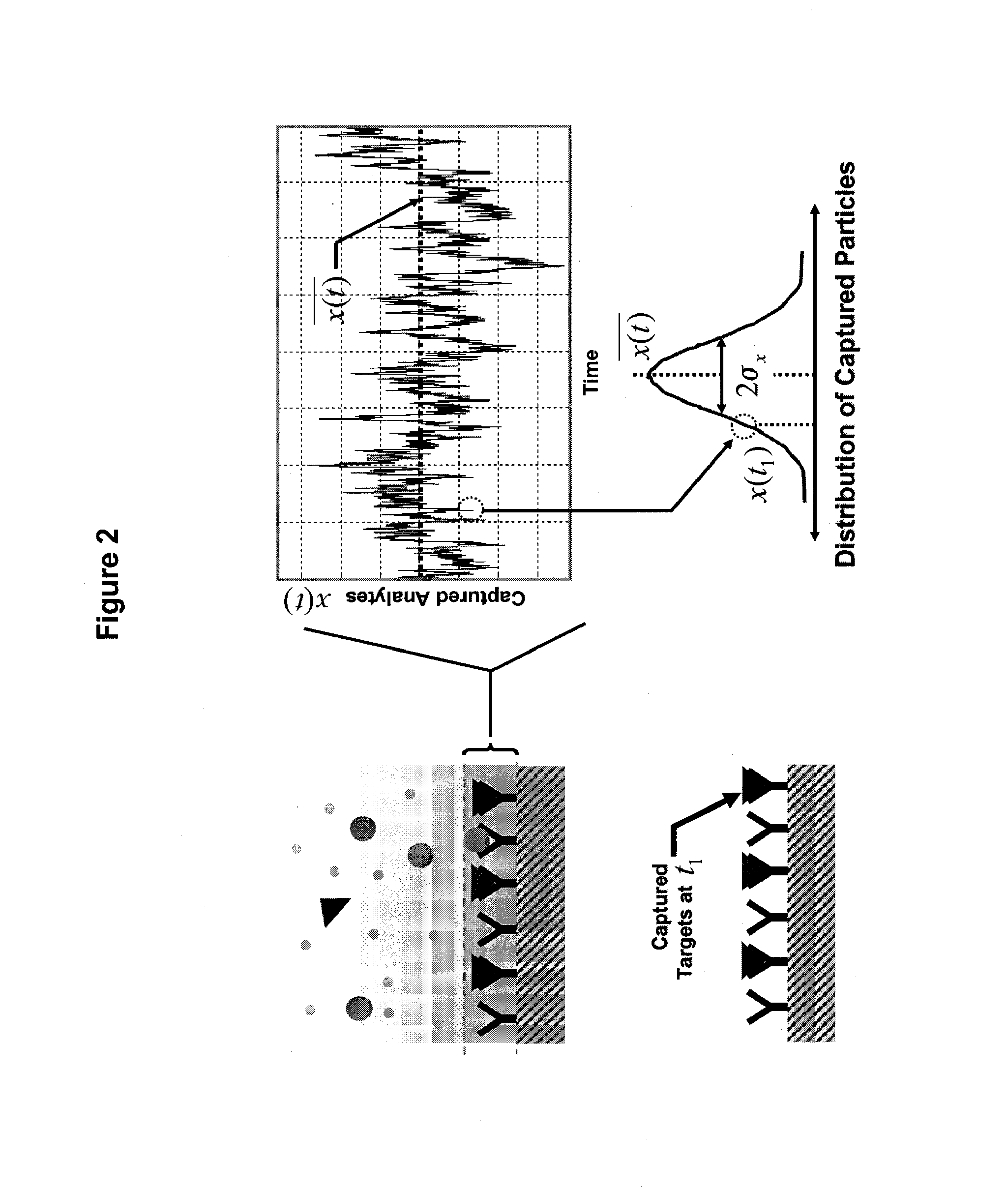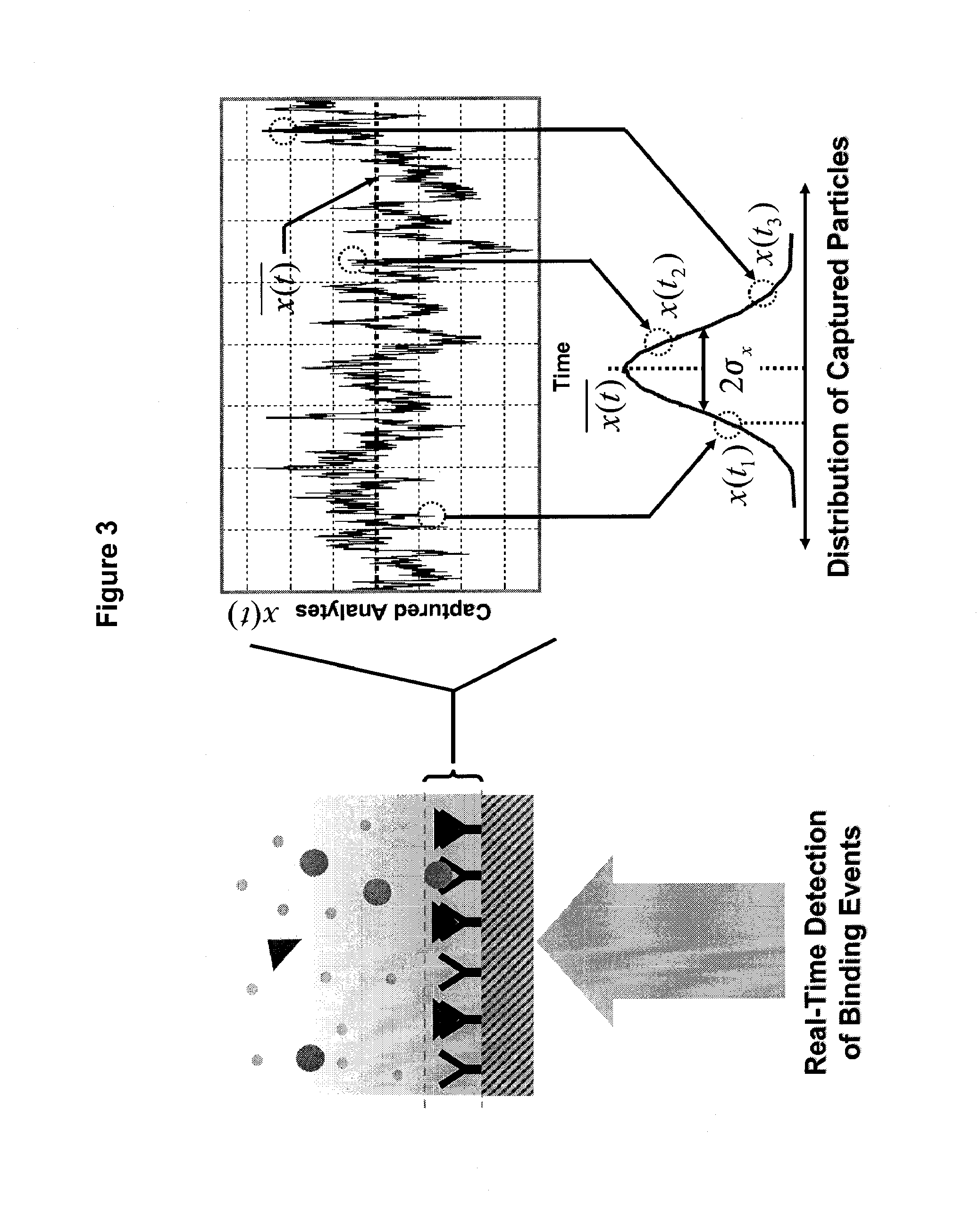Real time microarrays
a microarray and real-time technology, applied in the field of real-time microarrays, can solve the problems of the inability to predict the exact nature of the data, and the inability to accurately predict the data, etc., and achieve the effect of suppressing the effects of cross-hybridization
- Summary
- Abstract
- Description
- Claims
- Application Information
AI Technical Summary
Benefits of technology
Problems solved by technology
Method used
Image
Examples
example 1
[0239]FIG. 10 shows the layout of a 6×6 DNA microarray. Three different DNA probes (1, 2, and Control) with three different concentrations (2 μM, 10 μM, and 20 μM) are spotted and immobilized on the surface as illustrated. The probes contain a single Cy3 fluorescent molecule at the 5′ end. The DNA targets in this experiment contain a quencher molecule. The analyte binding in this system results in quenching of fluorescent molecules in certain spots. FIG. 11 shows a few samples of the real-time measurements of the microarray experiment wherein the control targets are added to the system. As illustrated in FIG. 11, the spots are quenched due to analyte binding.
[0240]FIGS. 12-15 each show data for 4 different spots with similar oligonucletide capturing probes. The target DNA analyte is introduced in the system at time zero and quenching (reduction of signal) occurs only when binding happens. For FIG. 12, the light intensity coefficient of variation was about 15%, however the estimated ...
example 2
[0242]This example provides a derivation of an algorithm, and the use of the algorithm to determine analyte concentration from a real-time binding data. The derivation proceeds as follows:
[0243]Assume that the hybridization process starts at t=0, and consider discrete time intervals of the length Δt. Consider the change in the number of bound target molecules during the time interval (iΔt, (i+1)Δt). We can write
nb(i+1)−nb(i)=[nt−nb(i)]pb(i)Δt−nb(i)pr(i)Δt,
where nt denotes the total number of target molecules, nb(i) and nb(i+1) are the numbers of bound target molecules at t=iΔt and t=(i+1)Δt, respectively, and where pb(i) and pr(i) denote the probabilities of a target molecule binding to and releasing from a capturing probe during the ith time interval, respectively. Hence,
[0244]nb(i+1)-nb(i)Δt=[nt-nb(i)]pb(i)-nb(i)pr(i).(1)
[0245]It is reasonable to assume that the probability of the target release does not change between time intervals, i.e., pr(i)=pr, for all i. On the o...
experimental example
[0271]Here we describe the experiments designed to test the validity of the proposed model and demonstrate the parameter estimation procedure. To this end, two DNA microarray experiments are performed. The custom 8-by-9 arrays contain 25mer probes printed in 3 different probe densities. The targets are Ambion mRNA Spikes, applied to the arrays with different concentrations. The concentrations used in the two experiments are 80 ng / 50 μl and 16 ng / 50 μl. The signal measured in the first experiment, where 80 ng of the target is applied to the array, is shown in FIG. 17. The smooth line shown in the same figure represents the fit obtained according to (7). In the second experiment, 16 ng of the target is applied to the array. The measured signal, and the corresponding fit obtained according to (7), are both shown in FIG. 18.
[0272]Applying (11)-(14), we obtain
pb=1.9×10−1,pr=2.99×10−5.
[0273]Furthermore, we find that
nt2 / nt2=β1*β2*=3.75 (15)
[0274]Note that the above ratio is relatively clo...
PUM
| Property | Measurement | Unit |
|---|---|---|
| time | aaaaa | aaaaa |
| roughness | aaaaa | aaaaa |
| roughness | aaaaa | aaaaa |
Abstract
Description
Claims
Application Information
 Login to View More
Login to View More - R&D
- Intellectual Property
- Life Sciences
- Materials
- Tech Scout
- Unparalleled Data Quality
- Higher Quality Content
- 60% Fewer Hallucinations
Browse by: Latest US Patents, China's latest patents, Technical Efficacy Thesaurus, Application Domain, Technology Topic, Popular Technical Reports.
© 2025 PatSnap. All rights reserved.Legal|Privacy policy|Modern Slavery Act Transparency Statement|Sitemap|About US| Contact US: help@patsnap.com



